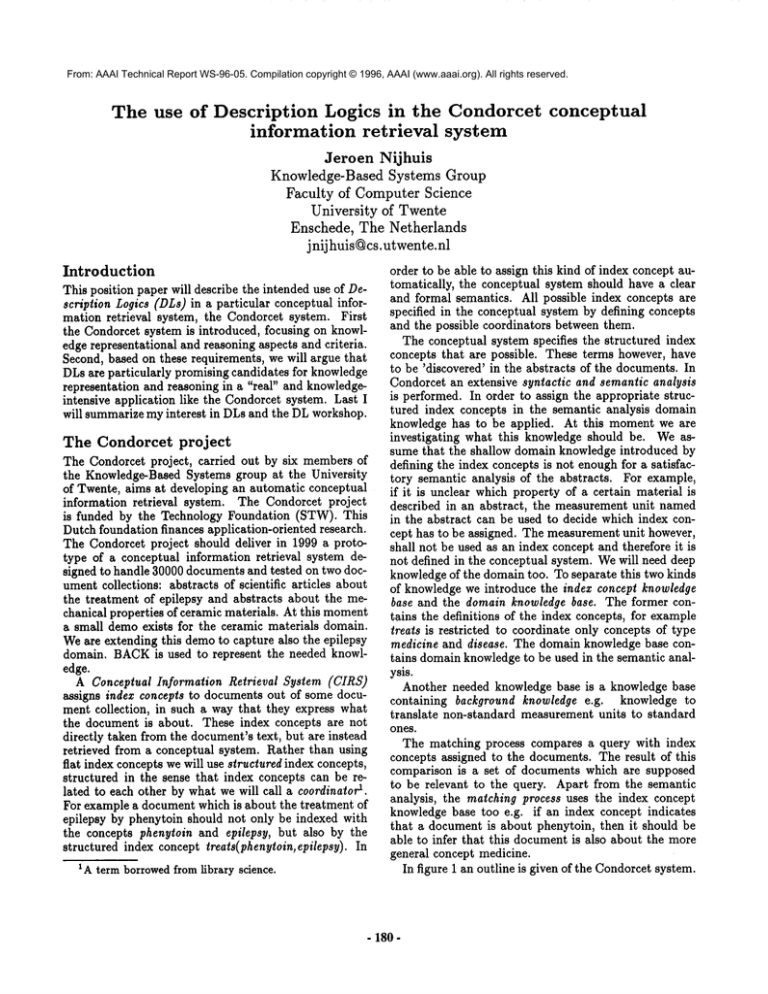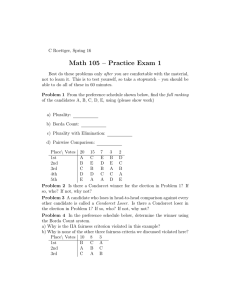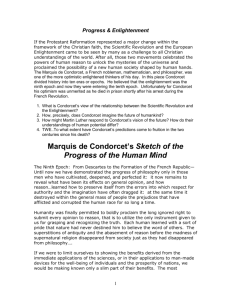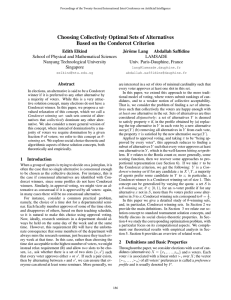
From: AAAI Technical Report WS-96-05. Compilation copyright © 1996, AAAI (www.aaai.org). All rights reserved.
The use of Description Logics in the Condorcet conceptual
information retrieval
system
Jeroen Nijhuis
Knowledge-Based
Systems Group
Faculty of Computer Science
University
of Twente
Enschede,
The Netherlands
j nij huis~cs.utwente.nl
Introduction
This position paper will describe the intended use of De.
scription Logics (DLs) in a particular conceptual information retrieval system, the Condorcet system. First
the Condorcet system is introduced, focusing on knowledge representational and reasoning aspects and criteria.
Second, based on these requirements, we will argue that
DLs are particularly promising candidates for knowledge
representation and reasoning in a "real" and knowledgeintensive application like the Condorcet system. Last I
will summarizemy interest in DLs and the DLworkshop.
The Condorcetproject
The Condorcet project, carried out by six members of
the Knowledge-Based Systems group at the University
of Twente, aims at developing an automatic conceptual
information retrieval system. The Condorcet project
is funded by the Technology Foundation (STW). This
Dutch foundation finances application-oriented research.
The Condorcet project should deliver in 1999 a prototype of a conceptual information retrieval system designed to handle 30000 documents and tested on two document collections: abstracts of scientific articles about
the treatment of epilepsy and abstracts about the mechanical properties of ceramic materials. At this moment
a small demo exists for the ceramic materials domain.
Weare extending this demoto capture also the epilepsy
domain. BACKis used to represent the needed knowledge.
A Conceptual Information Retrieval System (CIRS)
assigns index concepts to documents out of some document collection, in such a way that they express what
the document is about. These index concepts are not
directly taken from the document’s text, but are instead
retrieved from a conceptual system. Rather than using
fiat index concepts we will use structured index concepts,
structured in the sense that index concepts can be re1.
lated to each other by what we will call a coordinator
For example a document which is about the treatment of
epilepsy by phenytoin should not only be indexed with
the concepts phenytoin and epilepsy, but also by the
structured index concept treats(phenytoin, epilepsy). In
X A term borrowedfrom library science.
order to be able to assign this kind of index concept automatically, the conceptual system should have a clear
and formal semantics. All possible index concepts are
specified in the conceptual system by defining concepts
and the possible coordinators between them.
The conceptual system specifies the structured index
concepts that are possible. These terms however, have
to be ’discovered’ in the abstracts of the documents. In
Condorcet an extensive syntactic and semantic analysis
is performed. In order to assign the appropriate structured index concepts in the semantic analysis domain
knowledge has to be applied. At this moment we are
investigating
what this knowledge should be. Weassume that the shallow domain knowledge introduced by
defining the index concepts is not enough for a satisfactory semantic analysis of the abstracts. For example,
if it is unclear which property of a certain material is
described in an abstract, the measurement unit named
in the abstract can be used to decide which index concept has to be assigned. The measurement unit however,
shall not be used as an index concept and therefore it is
not defined in the conceptual system. Wewill need deep
knowledgeof the domain too. To separate this two kinds
of knowledge we introduce the index concept knowledge
base and the domain knowledge base. The former contains the definitions of the index concepts, for example
treats is restricted to coordinate only concepts of type
medicine and disease. The domain knowledge base contains domain knowledgeto be used in the semantic analysis.
Another needed knowledge base is a knowledge base
containing background knowledge e.g. knowledge to
translate non-standard measurement units to standard
ones.
The matching process compares a query with index
concepts assigned to the documents. The result of this
comparison is a set of documents which are supposed
to be relevant to the query. Apart from the semantic
analysis, the matching process uses the index concept
knowledge base too e.g. if an index concept indicates
that a document is about phenytoin, then it should be
able to infer that this document is also about the more
general concept medicine.
In figure 1 an outline is given of the Condorcetsystem.
- 180-
Figure 1: The Condorcet information retrieval process.
The (sub)processes and KBsare represented by ovals and
boxes. The horizontal arrows describe the flow through
the indexing subprocesses. The other arrows illustrate
the support of the KBs. The dotted lines indicate relations between various KBs.
Description
system
Logics and the Condorcet
[Meghini et al., 1993] use one DL, MIRTL,to model
the queries, the index terms, the index terminological
system, and the matching process. An important advantage of using one DLis that it is ensured the knowledge bases will participate in the retrieval process in
a uniform fashion [Meghini et al., 1993]. In the Condorcet project, however, more knowledge bases have
to be used. The trade-off between expressiveness and
tractability comes in two guises in the Condorcet project:
(1) high-expressiveness in the domain KB- not too demandingon worst-case tractability, and (2) relative lowexpressiveness in the index concept KB- high performanceand reliability. This is a design discussion I would
like to discuss: stick to one DLlanguage to represent all
knowledgesince this knowledgeis highly interrelated or
use more languages to capture the ontological, expressiveness and performance differences between the knowledge bases.
References
To represent the index concepts and the definitions of the
index concepts, a formalism is needed which is expressive
enough and has appropriate inferences like subsumption.
Description Logics seem to be very promising candidates:
(1) they are sufficiently expressive concept languages, (2)
they have a clear and sound theoretical foundation, (3)
the computational properties of the inference algorithms
are extensively studied, and (4) a number of DLsare implemented into software systems.
These are all requirements for the Condorcet application. (1) In the previous section I have explained that
we need an expressive concept language. (2) In order
maintain large knowledge bases (remember the system
should be able to handle 30000 documents) the semantics of the knowledgestructures have to be clear [$peel,
1995]. (3) Furthermore, to guarantee reliable performance, the computational properties of the inference algorithms have to be known. This is especially evident in
the matching process: in case the Condorcet system will
be used on-line a user should get an answer to a query
within a few seconds. Given the size of the knowledge
bases this will put a severe constraint on the knowledge
representation system. (4) The time-constraint of the
deliverance of the prototype requires that we reuse as
many existing resources as possible. A great advantage
of DLs is the availability of many implemented knowledge representation system based on them.
Workshop interest
[Borgida, 1995] A. Borgida. Description logics in data
management. IEEE transactions
on knowledge and
data engineering, 7:671-682, 1995.
[Buongarzoni et al., 1995] P. Buongarzoni, C. Meghini,
R. Salis, F. Sebastiani, and U. Straccia. Logical
and computational properties of the description logic
MIRTL. In International
workshop on Description
Logics, pages 80-84, Roma, Italy, June 1995.
[Doyle and Patil, 1991] Jon Doyle and RameshS. Patil.
Twotheses of knowledge representation: language restrictions, taxonomicclassification, and the utility of
representation services. Artificial Intelligence, 48:261297, 1991.
[Meghini et al., 1993] C.
Meghini,
F. Sebastiani, U. Straccia, and C. Thanos. A model of
information retrieval based on a terminological logic.
In Proceedings of SIGIR-93, 16th ACMInternational
Conference on Research and Development in Information Retrieval, pages 298-307, Pittsburgh, PA, 1993.
[Quantz et al., 1995] J. Joachim Quantz, Guido Dunker,
Manfred Gehrke, Uwe Kuessner, and Birte Schmitz.
FLEX-based disambiguation
in VERBMOBIL.In
International workshop on Description Logics, pages
112-118, Roma, Italy, June 1995.
[Speel, 1995] Piet-Hein Speel. Selecting knowledge representation systems. PhDthesis, Universiteit Twente,
1995.
The main reason for my interest in the DL workshop
is the possibility to discuss the use of DLs in conceptual information retrieval systems like Condorcet. To be
more specific, the use of DLs in knowledge-intensive applications (e.g. [Borgida, 1995], [Doyle and Fatil, 1991],
[Speel, 1995] etc.), the use of DLsin semantic analysis
(e.g. [Quantz et al., 1995]), the use of DLsin information
retrieval modeling(e.g. [Meghini et al., 1993], [Buongarzoni et al., 1995]) and the combination of those.
- 181-







